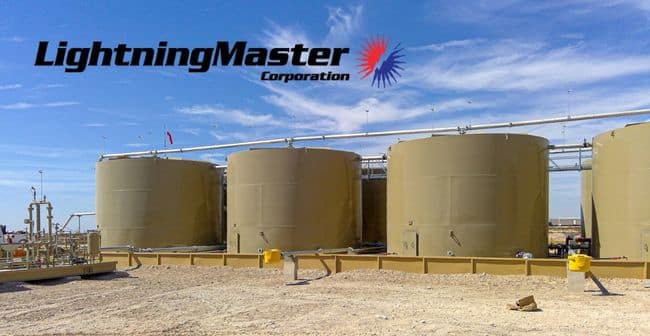How does Lightning Master Protect Tank batteries?
All existing facilities depending on their location and the presence of lightning, are recommended to be retrofitted with a lightning protection system. There are different technologies available but understanding which technology the best application is important. This can lead to their assets being vulnerable to direct and nearby strikes, especially during storm season.
Many insurance companies today are requiring that some type of lightning protection system be installed. Lightning ignition is not normally caused by the heating effect of lightning attachment. Unless the lightning discharge attaches to a vent, or near flammable vapors, ignition is usually a result of secondary effect or electromagnetic pulse (EMP) arcing produced by a direct or nearby strike.
Conditions Necessary for Ignition
There are two related causes of ignition in production, disposal, and flowback tanks: Static from normal operations and lightning. Static charge accumulation inside a tank occurs in the vapor droplets suspended above the stored product. Static charge accumulation on the exterior of a tank may be caused by atmospheric conditions, such as sand, dust or dry snow blowing across and around the tank.
If the charge reaches to an incendive level, it may arc to a metal object. Incendive means that the arc must have sufficient voltage and sufficient energy to cause an ignition. If the arc has sufficient energy and occurs in a flammable mixture, it may cause a fire or an explosion.
Protection Techniques
The systems solution to reducing the likelihood of ignition consists of three components:
The Basics of Tank Battery Lightning Protection
Whenever Lightning Master is tasked to protect a facility’s tank batteries, we take all the different components into account and provide the facility with a comprehensive lightning protection assessment and protection plan.
Tank Battery Lightning Protection Solutions
Bonding and grounding consists of electrically interconnecting all metallic objects at the site with conductors or through existing conductive piping, handrails, and other structures, so that they are at the same potential. Therefore, there is no opportunity for arcing between them. Bonding also consists of installing bonding jumper conductors across gaps created by insulators, such as between a thief hatch collar.
Grounding consists of connecting the bonded mass of the site structures and components to earth using the inherent self-grounding of flat bottom metal tanks, the site grounding grid (if installed) and/or ground rods if desired.
Grounding a tank, even a steel tank, has little effect on the static charge inside that tank. A fiberglass tank what is grounded less effect. Static charge dissipates from a fluid onto points and edges, not flat surfaces. That is why additional means are required to dissipate static charge buildup inside a tank.
Inside the tank, static control consists of installing in-tank-static drains (ITSDs) in each tank that contains produced water or other flammable gas producing products in order to bleed off static charge and equalize the potential of the vapor and liquid to the bonded mass of the site. Outside-the-tank static control consists of installing dissipating-type air terminals on the structure.
Structural lightning protection consists of adding an NFPA 780 type structural lightning protection (lightning rod) system to the site. Since the likelihood of ignition of a site is highly likely in the event of a direct lightning attachment in the presence of flammable gas, Lightning Master recommends the use of streamer-delaying air terminals to reduce the likelihood of streamer formation and a direct lightning attachment.
Customized Tank Battery Lightning Protection
Lightning protection systems are rarely an off-the-shelf application. Although a lot of sites are “exactly” the same, we recommend a physical site survey to determine proper bonding (especially if fiberglass tanks are on site) as well as determining the mounting hardware required based on piping, handrails, vents, site lights etc.
Lightning Master will design a system with industrial grade UL listed material. Industrial stainless-steel components are made for maximum corrosion resistance.
Contact Lightning Master for Tank Battery Lightning Protection
Lightning Master will survey your production tank batteries and disposal facilities to generate a turnkey proposal for lightning protection needs. If your facilities currently have an existing lightning protection system, industry standard (NFPA 780) recommends an annual inspection to check that the system is still in compliance.
Throughout the year, contractors can disconnect or change the facility, without reconnecting or expanding/changing the lightning protection system. Please reach out to us with your lightning protection questions and needs at (727) 447-6800.


